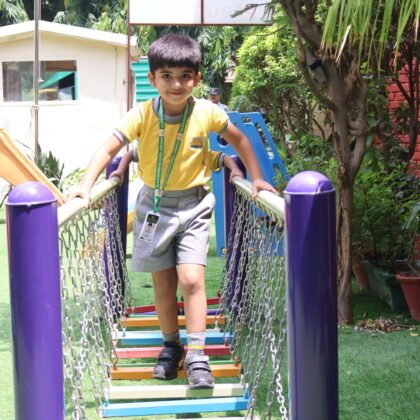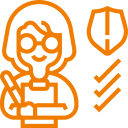SDG GOALS
SDGs and Their Relevance in Education
The Sustainable Development Goals (SDGs) are 17 interconnected targets set by the United Nations to create a fairer, healthier, and more sustainable world by 2030. They address urgent global concerns such as poverty, inequality, climate change, and access to education, recognising that progress in one area often fuels advancements in others.
For schools and educators, these goals are not just abstract ideals—they are practical blueprints for shaping future-ready citizens. By weaving SDG principles into K–12 education, classrooms become engines of change, equipping young learners with the knowledge, skills, and values they need to build a just and equal society.
SDGs and Ancient Indian Wisdom
Interestingly, the values embedded in the SDGs echo age-old Indian philosophy. The Sanskrit verse “Sarve Bhavantu Sukhinah”—found in the Garuḍa Purāṇa and Bhavishya Purāṇa—translates to “May all be happy” and resonates deeply with SDG 3: Good Health and Well-being, and SDG 16: Peace, Justice, and Strong Institutions.
Similarly, “Vasudhaiva Kutumbakam” from the Mahopaniṣad, meaning “The world is one family,” mirrors SDG 17’s emphasis on global partnerships and unity. The mantra “Tamaso Ma Jyotirgamaya”—“Lead me from darkness to light”—aligns with SDG 4, which champions inclusive, high-quality education that fosters wisdom and ethical living. These ancient ideals remind us that striving for sustainability, equity, and justice is deeply rooted in our cultural heritage.
Humanising SDGs Through Storytelling
Instead of telling young students what they “must” do, we can inspire them through stories—local, relatable, and actionable. A student who initiated a recycling drive or implemented water-saving methods becomes a powerful example for peers. Storytelling transforms global ambitions into tangible, achievable actions while building an emotional connection to the cause.
From Vision to Action: Our Role as Educators
The real question is not what the SDGs are, but how we can turn them into everyday practice. Educators and schools can lead by:
- Embedding SDG themes into daily lessons and activities.
- Supporting local projects like tree planting, waste segregation, or community gardens.
- Adopting equitable and sustainable policies across school operations.
The 2030 deadline is fast approaching. If we act now—with unity, creativity, and purpose—educators and students together can turn the SDGs from ambitious statements into everyday realities, creating a better and more sustainable world for all.
SDG 2: Zero Hunger

What It Is:
Sustainable Development Goal 2 aims to end hunger, achieve food security, improve nutrition, and promote sustainable agriculture. It’s about ensuring everyone—especially children—has access to sufficient, safe, and nutritious food all year round.
How ‘Healthy Bodies, Nourished Minds’ come alive in Classrooms
- Nutrition Education: Include lessons on balanced diets, not wasting food and the importance of regular, healthy meals.
- School Gardens: Encourage students to know from where food comes from and the value of fresh produce.
- Reduce Food Waste: Introduce “no waste lunch days” or composting programs to show the impact of reducing leftovers.
- Awareness Campaigns: Host assemblies, poster competitions, or storytelling sessions on hunger issues and sustainable farming.
- Cooking & Tasting Sessions: Involve children in simple, healthy snack preparations to promote interest in nutritious eating.
- Community Drives: Lead food donation or grain collection drives for underprivileged children.
How It Empowers Every Mind
- Promotes Health: Proper nutrition supports physical growth, concentration, and academic performance.
- Fosters Responsibility: Students learn to value food and make choices that minimise waste.
- Builds Empathy: Understanding hunger issues cultivates compassion and a desire to help others.
- Encourages Sustainability: Awareness of food sources and farming practices nurtures eco-conscious citizens.
- Strengthens Community Bonds: Participation in food-related initiatives creates a sense of unity and shared purpose.
SDG 4: Quality Education
Quality Education for All – Rooted in India’s Cultural Ethos
India has, for centuries, upheld the vision of education as a universal right. The timeless sentiment of “सर्वे भवन्तु सुखिनः”—“May all be happy, may all be wise”—captures the nation’s deep-rooted belief in collective well-being through the spread of knowledge. From the Gurukuls, madrasas, and pathshalas of the past, learning was never seen merely as skill acquisition for livelihood; it was equally a journey towards liberation (moksha), ethical living, and social harmony.
Mahatma Gandhi’s Nai Talim carried this legacy forward by blending intellect, empathy, and practical skills, fostering moral strength and self-reliance. Similarly, Rabindranath Tagore’s vision at Shantiniketan celebrated creativity, joy, and learning in close connection with nature. Drawing inspiration from these rich traditions, the National Education Policy 2020 reinforces that every child—irrespective of social or economic background—deserves access to equitable, high-quality education that nurtures the whole being.
SDG 4 – A step Towards True Learning
Sustainable Development Goal 4 is not limited to counting how many children enter school—it challenges us to look deeper at what and how they learn. It calls for a focus on measurable learning outcomes, equitable opportunities, life skill development, and safe, supportive learning spaces. The goal urges special attention to those often left on the margins—children in rural areas, girls, learners with disabilities, and those facing economic or social disadvantage. To truly live this vision, equity and inclusion must become guiding principles, supported by differentiated teaching methods and curriculum adaptations that meet diverse learner needs.
What Does ‘Quality’ in Education Truly Mean?
In education, “quality” is often misunderstood. It is far more than impressive exam scores or the presence of smart boards in classrooms. True quality lies in creating a rich, learner-focused environment that nurtures the whole child. When anchored in character formation, quality education embraces:
- Preparing the child holistically: Going beyond memorisation to cultivate critical thinking, creativity, and problem-solving.
- Innovative teaching approaches: Refreshing curricula and adopting engaging strategies that spark curiosity and inquiry.
- Empowered educators: Equipping teachers with the skills and mindset to be empathetic, inclusive, and adaptive.
- Safe, inclusive spaces: Ensuring classrooms are welcoming, gender-sensitive, and respectful to all.
- Life beyond the textbook: Embedding civic values, emotional literacy, ethical reasoning, sustainability awareness, and digital fluency into daily learning.
How Quality Education Transforms Lives
A high-quality education is an equaliser—it builds confidence, fuels creativity, and prepares learners to contribute meaningfully to their communities. It:
- Strengthens the ability to think critically, challenge injustice, and solve societal problems.
- Opens pathways to break cycles of inequality and discrimination.
- Cultivates empathy, sustainability values, and global citizenship.
When a society commits to quality education, it raises generations that are resilient, morally grounded, and ready to innovate.
Bringing SDG 4 Alive in Classrooms
The real power of Sustainable Development Goal 4 is unlocked when it moves from policy documents into everyday teaching practice. We do it through:
- Curriculum integration: Embedding SDG themes within lessons.
- Student agency: Encouraging learners to express ideas, create campaigns, and produce art that reflects social values.
- Inclusive pedagogy: Designing lessons that reach diverse learners through differentiated methods, visual tools, multilingual approaches, and socio-emotional support.
- Teacher enablement: Providing professional development in SDG-based lesson design, inclusive practices, child psychology, and the effective use of digital and AI tools.
Empowering Every Mind, Every Day
SDG 4 is woven into the very fabric of our school—visible in lessons, conversations, and teacher-student interactions. Our goal is to nurture minds that imagine, question, lead, and serve with purpose. When teaching blends knowledge with values and vision, we create learning that lasts a lifetime.















